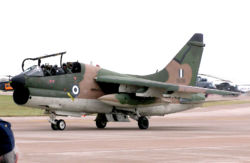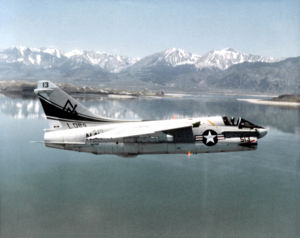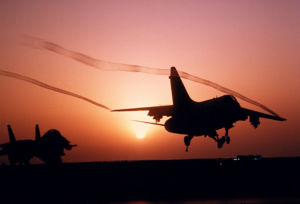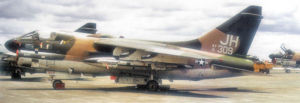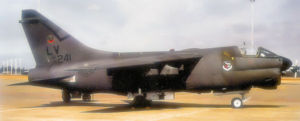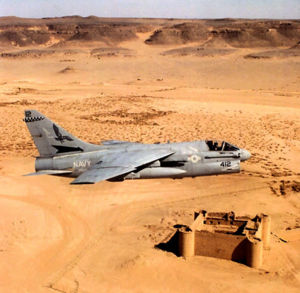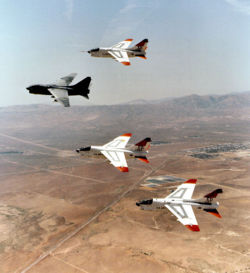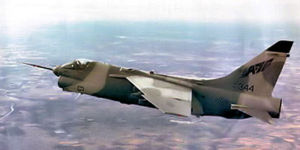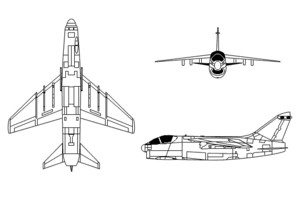PlaneSpottingWorld welcomes all new members! Please gives your ideas at the Terminal.
A-7 Corsair II
| A-7 Corsair II | |
|---|---|
| US Navy A-7A or B from VA-22 Fighting Redcocks | |
| Type | Attack aircraft |
| Manufacturer | Ling-Temco-Vought |
| Maiden flight | 1965-09-26 |
| Introduced | February 1967 |
| Retired | 1991 USAF |
| Primary users | United States Navy United States Air Force Greece Portugal |
| Number built | 1,569 |
| Unit cost | US$2.86 million |
| Developed from | F-8 Crusader |
The Ling-Temco-Vought A-7 Corsair II was a carrier-based subsonic light attack aircraft design that was introduced to replace the A-4 Skyhawk in US Naval service and based on the successful supersonic F-8 Crusader aircraft produced by Chance Vought. The A-7 was one of the first combat aircraft to feature a head-up display (HUD), doppler-bounded inertial navigation system (INS), and a turbofan engine. It initially entered service with the United States Navy during the Vietnam conflict and was then adopted by the United States Air Force to replace their A-1 Skyraiders that were borrowed from the Navy as well as with the Air National Guard. It was exported to Greece (in the 1970s), Portugal, and Thailand (in the late 1980s).
Contents
Development
In 1962, United States Navy began preliminary work on VAX (Heavier-than-air, Attack, Experimental), a replacement for the A-4 Skyhawk with greater range and payload. A particular emphasis was placed on accurate delivery of weapons to reduce the cost per target. The requirements were finalized in 1963 and in 1964 the Navy announced the VAL (Heavier-than-air, Attack, Light) competition. Contrary to USAF philosophy, which was to employ only supersonic fighter bombers such as the F-105 Thunderchief and F-100 Super Sabre, the Navy felt that a subsonic design could carry the most payload the farthest distance. One story illustrated that a "slow fat duck" could fly nearly as fast as a supersonic one, since carrying dozens of iron bombs also restricted its entry speed, but a fast plane with small wings and an afterburner would burn up a lot more fuel. To minimize costs, all proposals had to be based on existing designs. Vought, Douglas Aircraft, Grumman, and North American Aviation responded. The Vought proposal was based on the successful F-8 Crusader fighter, having an identical configuration, but more short and stubby, with a rounded nose. It was selected as the winner on 11 February 1964, and on 19 March the company received a contract for the initial batch of aircraft, designated A-7. In 1965 the aircraft received the popular name Corsair II, after Vought's highly successful F4U Corsair of World War Two.
Compared to the F-8 Crusader fighter, the A-7 had a shorter, broader fuselage. The wing was made larger, and the unique variable incidence wing of the F-8 was deleted. To achieve the required range, A-7 was powered by a Pratt & Whitney TF30-P-6 turbofan producing 11,345 lbf (50.5 kN) of thrust, the same innovative combat turbofan produced for the F-111, but without the afterburner need for supersonic speeds. Turbofans achieve more efficiency by moving unburned air at a lower velocity.
The aircraft was fitted with an AN/APQ-116 radar which was integrated into the ILAAS digital navigation system. The radar also fed a digital weapons computer which made possible accurate delivery of bombs from a greater stand-off distance, greatly improving survivability compared with faster platforms such as the F-4 Phantom II. It was the first US aircraft to have a modern heads-up display, now a standard instrument, which displayed information such as dive angle, airspeed, altitude, drift, and aiming reticle. The integrated navigation system allowed for another innovation -- the projected map display system (PMDS) accurately showed aircraft position on two different map scales.
The A-7 enjoyed the fastest and most trouble-free development period of any American combat aircraft since the second world war. The YA-7A made its first flight on 27 September 1965, and began to enter Navy squadron service late in 1966. The first Navy A-7 squadrons reached operation status on 1 February 1967, and began combat operations over Vietnam in December of that year.
Secretary of Defence Robert McNamara prodded the Air Force to adopt not only the hugely successful F-4 Phantom II, but also the Navy's A-7 Corsair as a low cost follow-on to F-105s until the troubled F-111 came online. The Air Force ordered the A-7D with a fixed high speed refueling receptacle behind the pilot optimized for the KC-135's flying boom rather than the folding long probe of Navy aircraft. They opted for the M61 Vulcan gatling gun rather than the twin single-barrel 20 mm cannon, and changed to the Allison TF41-A-1 engine, which was a licenced version of the British Rolls-Royce Spey. The TF41-A-1 engine produced 14,500 lbf (64 kN) of thrust. Later Navy versions would adopt this gun and engine.
Production of Corsairs continued through 1984 yielding a total of 1,569 aircraft built. The A-7 Corsair has the distinction of being the only United States Navy jet fighter/bomber, of the 1960's, that was designed, built, and deployed directly into the Vietnam War.
Operational history
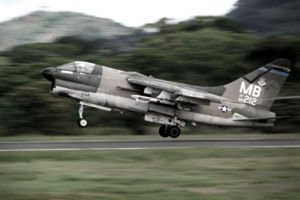
The A-7 Corsair II was tagged with the nickname "SLUF" (Short Little Ugly Feller) by pilots.
Pilots of the early A-7s lauded the aircraft for general ease of flying (with the exception of poor stability on cross-wind landings) and excellent forward visibility but noted a lack of engine thrust. This was addressed with A-7B and more thoroughly with A-7D/E. The turbofan engine provided a dramatic increase in fuel efficiency compared with earlier turbojets -- the A-7D was said to have specific fuel consumption one sixth that of an F-100 Super Sabre at equivalent thrust. An A-7D carrying 12x 500 lb (227 kg) bombs at 480 mph (775 km/h) at 33,000 ft (10,000 m) used only 3,350 lb (1,500 kg) of fuel per hour. The integrated weapons computer provided highly accurate bombing with CEP of 60 ft (20 m) regardless of pilot experience. The doppler navigation system required a mere 2.5 minutes on the ground for partial alignment, a big improvement over 13 minutes required in F-4 Phantom II. In addition, the A-7 required only 11.5 man hours of maintenance per mission resulting in quick turnaround and high number of combat-ready aircraft.
Southeast Asia
In Vietnam, the hot, humid air robbed even upgraded A-7D and A-7E of power. Takeoff rolls were lengthy and fully-armed aircraft struggled to reach 500 mph (800 km/h). Pilots quipped that the Corsair "is not very fast, but it sure is slow" (Higham 1978). For dissimilar air combat training, and the Blue Angels, the Navy would chose the more nimble A-4 Skyhawk as a subsonic maneuvering platform, as some considered the A-7 to be inadequate in air combat. The Marine Corps would also pass on the Corsair, they would opt instead for the V/STOL vertical landing AV-8 Harrier as their light attack aircraft to replace their A-4F/M Skyhawks.
The first US Navy A-7As were deployed to Vietnam in 1967 with VA-147 Argonauts aboard USS Ranger (CVA-61). The aircraft made their first combat sortie on 4 December 1967. In the following months, VA-147 flew around 1,400 sorties losing only one aircraft. In January 1968, USS Ranger participated in the incident surrounding the capture of USS Pueblo (AGER-2) in the Sea of Japan by North Korea. The Navy's improved A-7B model arrived in Vietnam in early 1969, with the definitive A-7E following in 1971. The U.S. Navy's first A-7 loss occurred on 22 December 1967, less than three weeks after entering combat. The Corsair from VA-147, USS Ranger, was piloted by LCDR James M. Hickerson, was attacking a AAA site when a SAM exploded under his aircraft, his engine and hydraulics failed and he ejected. LCDR Hickerson was released as a POW on 14 March 1973. The last U.S. Navy A-7 Corsair lost during the war was 29 January 1973, when CDR T.R. Wilkinson of VA-147, from the carrier USS Constellation, disappeared after being launched on a training flight; he was listed as KWF (killed while flying). From 1967 thru 1973, ten of the twenty U.S. Navy aircraft carriers fighting off of the Vietnam coast lost A-7's, 15 of which were shot down by surface to air missiles (SAMs): USS Ticonderoga lost 3, USS Constellation lost 15, USS Ranger lost 11, USS Coral Sea lost 13, USS Midway lost 2, USS Oriskany lost 8, USS Saratoga lost 8, USS Kitty Hawk lost 13, USS Enterprise lost 3, and the USS America lost l6.[5]
The USAF A-7Ds were also widely used in Vietnam and Cambodia with 354th Tactical Fighter Wing, and the 388th Tactical Fighter Wing, flying from Korat RTAFB, Thailand. A-7s from the 354th TFW entered action in October 1972 and attacked targets as far as 500 mi (800 km) from airbases, extensively utilizing mid-air refueling. The A-7Ds were quickly assigned the "Sandy mission" of providing air cover for rescue of downed pilots. Taking over for A-1 Skyraiders (hence the name "Sandy"), the A-7's higher speed was somewhat detrimental for escorting the helicopters but the aircraft's high endurance and durability were an asset and it performed admirably. On 18 November 1972, Major Colin A. Clarke led a successful mission near Thanh Hoa to rescue a downed F-105 Wild Weasel crew. The mission lasted a total of 8.8 hours during which Clarke and his wingman took a number of hits from 13 mm (0.51 cal) anti-aircraft fire. For his actions in coordinating the rescue, Clarke was awarded the Air Force Cross, the USAF's second-highest medal. The USAF A-7D flew a total of 12,928 combat sorties during the war with only 6 losses -- the lowest of any US fighter in the theatre. The aircraft was second only to B-52 Stratofortress in the amount of ordnance dropped on Hanoi and dropped more bombs per sortie with greater accuracy than any other US attack aircraft. The first USAF A-7 Corsair to be lost was piloted by Capt. Anthony C. Shine of the 353rd Tactical Fighter Squadron. On 02 December 1972 Capt. Shine was flying a Search and Rescue mission (SAR) when he disappeared through a low cloud to identify a target. A three day search failed to locate Capt. Shine nor his Corsair. One of Capt. Shine's brothers, 1LT J.C. Shine had been killed in action in Vietnam on l5 October 1970. In 1993, Capt. Anthony Shine's daughter was determined to find her father's remains and went to Vietnam, searching the crash site herself. Capt. Anthony Shine's remains were returned to the United States in June 1995, formally identified in 1996, and buried with full military honours in Arlington National Cemetery in 1996. On 24 December 1972 an A-7 from the 353rd TFS was diving into the attack on an enemy gun position, when the 0-1 Bird Dog that was directing the attack pulled up into the Corsair's path; the Corsair cut thru the 0-1, sending it twisting to the ground, killing it's pilot. Capt. Riess had to eject from his badly crippled aircraft, and was captured by the NVA (North Vietnames Army). He was released as a POW on 28 March 1973. On 11 January 1973 an A-7 from the 355th TFS was on an escort mission, when it's engine failed. The pilot ejected and survived. On 17 February 1973 MAJ Gallagher from the 354 TFS was flying his A-7 during a close air support mission when he was hit by AAA fire at 15,000 feet, he ejected and survived. On 04 May 1973, 1LT T.L. Dickens, from the 3rd TFS, was piloting his Corsair during an attack on an enemy river craft, when he was hit by enemy ground fire. He ejected safely and survived. On 25 May 1973, Capt. Jeremiah Costello of the 354th TFS was flying a close air support mission when he was hit by enemy AAA fire. His body was recovered by an H-53 helicopter; Capt. Costello's Corsair was the last A-7 lost in the Vietnam War.[5]
A-7Ds from Korat flew combat operations over Vietnam until mid-Jan 1973, in Laos until 22 February 1973, and in Cambodia until 15 August 1973. The last shot fired in anger by United States military forces in Southeast Asia was fired by an A-7D of the deployed 345th TFW / 353 TFS assigned to Korat RTAFB on 15 August 1973. During the war in Southeast Asia, U.S. Navy A-7 Intruders were gray/white in color; USAF A-7's were normally painted in full camoflage paint schemes. The U.S. Navy did experiment with camoflage paint schemes for some of their aircraft during the war, but during landing operations, the flight deck crews found their duties complicated, due to the inherent changing of the weather conditions aboard a moving ship and the color coded uniforms of the flight deck crew; with the added dangers involved to an already cluttered flight deck, it was determined to keep naval aircraft readily visible for the sake of safety.
On 15 May 1975, A-7D aircraft assigned to the 388th TFW / 3d TFS at Korat RTAFB provided air cover in what is considered the last battle of the Vietnam war, the recovery of the SS Mayagüez after it was highjacked by Cambodian communists.
Grenada
Navy A-7E squadrons VA-15 and VA-87, from the USS Independence, provided close air support over Grenada in October 1983
Lebanon
Navy A-7s also provided air support during the U.S. mission in Lebanon in 1983. One A-7, along with an A-6 Intruder, were shot down by Syrian surface-to-air missiles (SAM) on December 4, 1983.
Libya
On March 24, 1986, during the Gulf of Sidra dispute with Libya, Libyan air defense operators fired SA-5 missiles at two VF-102 F-14s from USS America orbiting on a Combat Air Patrol (CAP) station. The next day, a Navy A-7E aircraft accompanied the fighters and responded to the SA-5 radar emissions by firing the first AGM-88A HARM missiles used in combat and destroying it.
In April 1986, Navy Sixth Fleet A-7Es from VA-72 and VA-46 aboard USS America also participated in Operation El Dorado Canyon, the retaliatory attack on Libya using HARM and Shrike anti-radar missiles.
Panama
The Ohio Air National Guard 180th Tactical Fighter Group was in Panama when hostilities began in late December 1989 and participated in Operation Just Cause. They were among the ANG units that rotated to Howard Air Force Base to provide a presence in Panama Cornet Cove deployment exercises.
F-117 Development
The 4450th Tactical Group stationed at Nellis AFB, Nevada had the unique distinction of being the last active USAF unit to operate the A-7 Corsair II. The mission of the 4450th TG was the operational development of the F-117 Nighthawk, and the unit needed a surrogate aircraft for pilot training and practice. A-7Ds and A-7Ks were obtained from various active-duty and national guard squadrons and were assigned initially to the "(P)" unit of the 4450th TG, redesignated the 4451st Tactical Squadron in January 1983.
The A-7s were used as a deception and training aircraft by the group between 1981 and 1989. It was selected because it demanded about the correct amount of pilot workload expected in the F-117A, was single seat, and many of the F-117A pilots had F-4 or F-111 backgrounds. A-7s were used for pilot training before any F-117As had been delivered to bring all pilots to a common flight training base line. Later, the A-7s were used to chase F-117A tests and other weapon tests at the Nellis Range.
A-7 flight operations began in June 1981 concurrent with the very first YF-117A flights. The A-7s wore a unique "LV" tailcode (for Las Vegas) and had a dark purple/black paint motif. The A-7s were based officially at Nellis Air Force Base and were maintained by the 4450th Maintenance Squadron.
In addition to providing an excuse for the 4450th's existence and activities the A-7s were also used to maintain pilot currency, particularly in the early stages when very few production F-117As were available. The pilots learned to fly chase on F-117A test and training flights, perform practice covert deployments, and practice any other purpose that could not be accomplished using F-117As, given the tight restrictions imposed on all F-117A operations.
Some A-7s operated from the Tonopah Test Range Airport, about 30 miles southeast of Tonopah, Nevada where the F-117s were being operationally tested and care was taken to leave them outside the aircraft hangars during the daytime. The existence of A-7s on the Tonopah flightline would not interest Soviet intelligence agencies when examining spy satellite imagery of the base. That way the Soviets would see that Tonopah operated nothing more exciting than some Corsairs. As part of the deception and to develop deployment procedures, the 4451st TS deployed A-7s to Kunsan AB, South Korea in 1984 to "act" as a normal operational squadron.
There were approximately 20 A-7D aircraft used in developing the F-117, including several two seat TA-7K trainers. In January 1989, just three months after the USAF admitted the F-117A existed, the A-7s were retired to AMARC and were replaced by AT-38B Talons as training aircraft and the 4451st TS was deactivated.
Operation Desert Shield/Storm
While USAF A-7s stayed home in favor of A-10s, the Navy deployed two of their last A-7E squadrons to Operation Desert Shield in August 1990 aboard USS John F Kennedy, the only carrier of six deployed to Desert Storm to operate the A-7 except for USS Saratoga that hosted one VA-72 A-7 which mistakenly landed aboard her when the Kennedy and Saratoga swapped station during the pilot's mission. VA-46 and VA-72 made the last combat sorties of the A-7 in Operation Desert Storm flying from the Red Sea to targets throughout Iraq. The A-7 was used both day and night to attack a wide range of heavily-defended deep interdiction targets in Iraq as well as "kill boxes" (geographically defined kill zones) in Kuwait, employing a variety of weapons including precision-guided munitions (PGM's), such as the TV-guided Walleye glide bomb, unguided general purpose bombs, and High Speed Anti-Radiation missiles (HARM). The A-7 was also used as a tanker in numerous in-flight refueling missions.
Retirement
US Navy A-7 Corsairs began being phased out of the fleet during the mid 1980s with the arrival of the McDonnell Douglas (Now Boeing) F/A-18 Hornet. The last Navy A-7s were retired by the last fleet operational squadrons (VA-46 and VA-72) in May 1991 shortly after their return from Desert Storm. The F-16 Fighting Falcon would also largely replace the A-7 as the Air Force's high performance attack fighter. Even with an advanced technology afterburning turbofan, some still remark that the F-16 lacks the range of the old A-7. The complaint that the Hornet lacked range reached such a level that the even larger F/A-18E/F Super Hornet was scaled up to carry more fuel.
By 1981, the Fairchild A-10 Thunderbolt II took over the Air Force close air support (CAS) role from the A-7s with active duty units. With the exception of the A-7s used in the F-117 program, the last active-duty Corsairs were used by the 23d Tactical Fighter Wing at England Air Force Base Louisiana in 1981. Many active-duty pilots missed the performance and sophistication of the Corsair.
Active-duty US Air Force A-7Ds were transferred to Air National Guard (ANG) units beginning in 1974, with new twin seat A-7K's built starting in 1979 being sent directly to the ANG. The last USAF Air National Guard Corsairs were retried in 1993 by the ANG units at Rickenbacker ANGB (Ohio), Des Moines (Iowa), Tulsa (Oklahoma) and Springfield (Ohio).
Some of these surplus aircraft were passed to Greece, Thailand and Portugal; however by the end of 1998, with the exception of some airframes used as static displays, all US A-7s were disposed of by AMARC.
The Portuguese Air Force A-7s (designated A-7P, TA-7P) were 20 converted Navy A-7As and 6 TA-7C airframes powered by the TF30-P408 engine and were equipped with A-7E avionics. Deliveries to Portugal began in May 1981 and were completed by May 1986. These aircraft were retired in 2001.
A re-engined variant (YA-7F) was proposed with near-sonic performance with afterburners, but this concept would lose out to the F-16 Fighting Falcon and F/A-18 Hornet (see below).
Current Use
A-7s are still used by Greek (Hellenic) Air Force (Elliniki Polemiki Aeroporia) and the Royal Thailand Navy Air Arm (Kong Tha Han Lur Thai).
Greek A-7H and TA-7H aircraft are flown by the 115th Fighter Wing at Souda Air Base, and A-7E and TA-7C by the 116th Fighter Wing at Araxos Air Base. Their tactical role is ground target attack and bombardment.
The Royal Thai Navy purchased 14 A-7E and 4 TA-7C airplanes for coastal defense and sea patrol duties. They were delivered during the summer of 1995. They are in service with the 104th "White Shark" squadron, 1st Wing at U-Tapao International Airport.
Both the Greek and Thai A-7s have been upgraded with many improvements, such as greater thrust from their TF-41 engines, upgraded avionics, radar, and full day/night capabilities.
Variants
- A-7A - First production version. Early USN Corsair IIs had two 20 mm Colt Mk 12 cannons with 250 rounds per gun. Maximum ordnance, carried primarily on the wing pylons, was theoretically 15,000 lb (6,804 kg), but was limited by maximum takeoff weight, so the full weapon load could only be carried with greatly reduced internal fuel. 199 built.
- A-7B - Uprated TF30-P-8 engine with 12,190 lbf (54.2 kN) of thrust. In 1971, surviving A-7B were further upgraded to TF30-P-408 with 13,390 lbf (59.6 kN) of thrust. 196 built.
- A-7C - first 67 production A-7E with TF30 engines.
- TA-7C - two-seat trainer version for US Navy, 24 converted from A-7B, 36 from A-7C. Upgraded to A-7E standard in 1984.
- A-7D - In the footsteps of recently adopting another Navy design, the F-4 Phantom II, USAF requested a version of A-7 for Tactical Air Command to fulfill the need for an inexpensive close-air support replacement for A-1 Skyraider. On 5 November 1965 the USAF announced that it would purchase a version of the A-7, designated the A-7D. The most important difference from Navy versions was adoption of the Allison TF41-A-1 turbofan, a license-built version of British Rolls-Royce Spey. With 14,500 lbf (64.5 kN) of thrust, the engine offered a considerable boost in performance. In addition, avionics were upgraded, internal armament was changed to a single 20 mm M61 Vulcan gatling cannon, and the in-flight refueling method was changed from probe-and-drogue to the boom. The YA-7D prototype with TF30 flew on 6 April 1968, with the first TF41 aircraft taking to the air on 26 September 1968. The aircraft were later updated to carry the Pave Penny laser spot tracker to add the capability to drop guided bombs. 459 built.
- A-7E - the Navy was so impressed with the performance gain of USAF A-7D that they ordered their own version with the TF41 engine. The first prototype flew on 25 November 1968. In 1986, 231 A-7E were equipped to carry the LANA (Low-Altitude Night Attack) pod which projected amplified light image on the HUD and, in conjunction with radar, provided terrain following down to 460 mph (740 km/h) at 200 ft (60 m). 529 built (not counting 67 A-7C).
- YA-7F (A-7D Plus, A-7 Strikefighter) - In 1985, USAF requested proposals for a fast strike aircraft because of concerns that A-10 Thunderbolt II was too slow for interdiction. The design called for a new engine, either the Pratt & Whitney F100 or General Electric F110. LTV responded with a supersonic version of A-7 powered by a F100-PW-220 with 26,000 lbf (116 kN) of thrust. To accommodate the new engine, the fuselage was lengthened about 4 ft (1.22 m). New fuselage sections were inserted in both the forward and aft fuselage - a 30 in (76 cm) section in front of the wing and an 18 in (46 cm) section behind the wing. The wing was strengthened and fitted with new augmented flaps, leading edge extensions and automatic maneuvering flaps. The vertical stabilizer height was increased about 10 in (25 cm). Ironically, the end result resembled the F-8 Crusader from which the A-7 was originally derived. Two A-7D were modified, the first one flying on 29 November 1989 and breaking the sound barrier on its second flight. The second prototype flew on 3 April 1990. The project was cancelled in favor of the F-16 Fighting Falcon.
- A-7G - proposed version for Switzerland, none built
- A-7H - Modified A-7E for Greece without air-refuelling capability, 60 built.
- TA-7H - two-seat trainer version for Greece
- EA-7L - 8 TA-7C modified into electronic aggressor aircraft used by VAQ-34, upgraded to A-7E standard in 1984
- TA-7K - two-seat trainer version for Air National Guard, 30 built
- A-7P - rebuilt ex-Navy A-7A for Portugal
- TA-7P - two-seat trainer version for Portugal
- YA-7E or YA-7H - two-seat prototypes built by Ling-Temco-Vought as a private venture.
Operators
- Template:GRE: Hellenic Air Force
- Template:POR: Portuguese Air Force
- Template:THA: Royal Thai Navy
- Template:USA: US Air Force, US Navy
- See also: List of units using the A-7 Corsair II
- See also: A-7D Production Data
Specifications (A-7D)
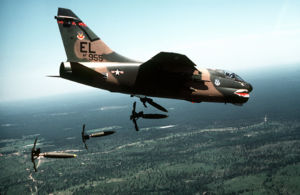
General characteristics
- Crew: 1
- Length: 46 ft 1.5 in (14.06 m)
- Wingspan: 38 ft 9 in (11.81 m)
- Height: 16 ft 0.75 in (4.90 m)
- Wing area: 375 ft² (34.8 m²)
- Airfoil: NACA 65A007 root and tip
- Empty weight: 19,915 lb (9,033 kg)
- Loaded weight: 29,040 lb (13,200 kg)
- Max takeoff weight: 42,000 lb (19,050 kg)
- Powerplant: 1× Allison TF41-A-1 turbofan, 14,500 lbf (64.5 kN)
Performance
- Maximum speed: 606 knots (698 mph, 1,123 km/h at sea level)
- Cruise speed: 465 knots (535 mph, 860 km/h)
- Combat radius: 621 nm (715 mi, 1,150 km)
- Ferry range: 2,485 nm (2,860 mi, 4,600 km (with 4-300 Gal external tanks))
- Service ceiling: 42,000 ft (12,800 m)
- Rate of climb: 15,000 ft/min (76 m/s)
- Wing loading: 77.4 lb/ft² (379 kg/m²)
- Thrust/weight: 0.50
Armament
- Guns: 1× 20 mm (0.787 in) M61 Vulcan gatling gun with 1,030 rounds
- Missiles: 2× AIM-9 Sidewinder, on one each side of fuselage
- Bombs: 15,000 lb (6,800 kg) on six external hardpoints, compatible with a wide range of general-purpose bombs, including:
- Up to 30× 500 lb (230 kg) Mark 82 bombs
- Rocket pods
- Paveway laser-guided bombs
- AGM-45 Shrike, AGM-62 Walleye, AGM-65 Maverick, AGM-88 HARM, and GBU-15 electro-optical glide bombs
- 1× B28, B57, or B61 nuclear bomb
References
- Donald, David; Lake, John (1996). Encyclopedia of world military aircraft. AIRtime Publishing. ISBN 1-880588-24-2.
- Higham, R.; Williams, C. (1978). Flying combat aircraft of USAAF-USAF (Volume 2). Air Force Historical Foundation. ISBN 0-8138-0375-6.
- Swanborough, G.; Bowers, P.M. (1989). United States Military Aircraft Since 1909. Smithsonian. ISBN 0-87474-880-1.
- Swanborough, G.; Bowers, P.M. (1990). United States Navy Aircraft Since 1911. Naval Institute Press. ISBN 0-87021-792-5.
- Hobson, Chris. (2001) VIETNAM AIR LOSSES. ISBN 1-85780-1156
External links
Related content
Related development
Comparable aircraft
Designation sequence
Related lists
Lists relating to aviation | |
|---|---|
| General | Timeline of aviation · Aircraft · Aircraft manufacturers · Aircraft engines · Aircraft engine manufacturers · Airports · Airlines |
| Military | Air forces · Aircraft weapons · Missiles · Unmanned aerial vehicles (UAVs) · Experimental aircraft |
| Notable incidents and accidents | Military aviation · Airliners · General aviation · Famous aviation-related deaths |
| Records | Flight airspeed record · Flight distance record · Flight altitude record · Flight endurance record · Most produced aircraft |
